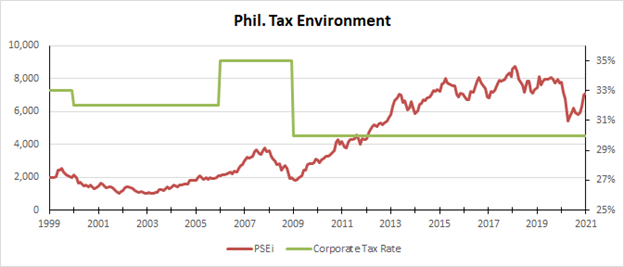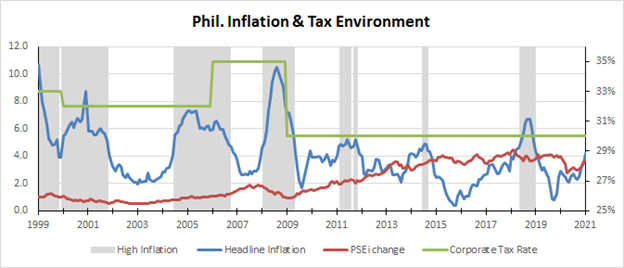MONDAY MACRO: Although a lot of signals warrant investor bullishness, this indicator gives pause to such sentiment in the near term

In a simplified world, higher long-term profitability for businesses will cause current stock prices to rise. This is what many investors are hoping the Philippines’ corporate tax reform will bring.
However, another signal is flashing potentially worrisome signals, which can impede near-term growth if it gets worse.
Philippine Markets Daily:
The Monday Macro Report
Powered by Valens Research
Over the past few weeks, we’ve talked at length about the Corporate Recovery and Tax Incentives for Enterprises (CREATE) Act. We discussed its general implications and its likely impact on the Philippine government and businesses specifically.
Today, we take a look at the CREATE Act’s impact on the stock market. With the potential benefits long-term tax revenues and business profitability will likely get once the tax reform is passed into law, there is much for investors to be optimistic about.
Holding everything else constant, greater long-term after-tax profitability should improve a company’s equity and the value of each owner’s share. Applying this concept to every publicly traded company and we see the overall Philippine stock market rising.
During the last corporate tax change when the corporate income tax rate fell from 35% in 2008 to 30% in 2009, it allowed the Philippine Stock Exchange Index (PSEi) to rise to as much as 9,000 levels.

However, the PSEi’s uptrend wasn’t just one smooth line, but rather it was a series of peaks and troughs in a general upswing. To better understand how the stock market performs in much smaller time periods, another indicator must be considered, specifically the inflationary environment.
Inflation is the general increase in the prices of goods and services in the economy. While it seems personally desirable to see prices go down, it isn’t beneficial for the economy since it is in everyone’s interest to delay their spending and sacrifice consumption today.
Consumer spending is crucial to the economy. It stimulates economic activity and creates demand for businesses. With inflation, people are more inclined to spend, but too high an inflation can incite panic buying and destabilize the economy.
As such, periods of low inflation are normally preferred over high inflation and deflation scenarios.
The stability of the Philippine inflation rate is managed by the Bangko Sentral ng Pilipinas (BSP), by controlling the money supply and providing a guidance range for inflation within the next few years.
That said, there are still times when external factors can push the inflation rate outside or near the end of the BSP’s guidance range. This induces economic uncertainty as people start to lose confidence in the BSP’s ability to execute its main function.
The riskier environment makes it more difficult for the economy and for businesses to operate, causing stock prices to stagnate or plummet.
The chart below shows the PSEi’s historical performance (red line), alongside the inflation rate (blue line) and corporate income tax rate (green line). It also highlights periods of high inflation or inflation greater than 4.7% (gray bars).

The chart shows that the PSEi’s greatest period of growth (post-2009) wasn’t just accompanied by a more favorable tax environment, but also more favorable inflation. When inflation spiked in 2011, mid-2014, and 2018, the PSEi saw either sluggish or negative growth.
The key takeaway here is that for the stock market to earn high returns, relatively low taxes and inflation must be present. With the CREATE Act close to passing, corporate income taxes will become even lower, but given the Philippines’ current situation, inflation seems to be heading for the opposite direction.
Last December, we talked about the inflation rate slowly creeping up to 3.3% despite lower consumer confidence levels. The African Swine Fever and other disruptions in the food supply chain have caused agricultural prices to shoot up.
Although inflation was previously expected to stay at moderate levels, the BSP now estimates the inflation rate to hit 4.7% in February 2021. The quick rise in global crude oil prices is now pushing prices up as well.
If the current inflation trend does surpass the high inflation mark of 4.7%, then near-term upside will likely be capped and a stock market rally event may likely come later than expected.
About the Philippine Market Daily
“The Monday Macro Report”
When just about anyone can post just about anything online, it gets increasingly difficult for an individual investor to sift through the plethora of information available.
Investors need a tool that will help them cut through any biased or misleading information and dive straight into reliable and useful data.
Every Monday, we publish an interesting chart on the Philippine economy and stock market. We highlight data that investors would normally look at, but through the lens of Uniform Accounting, a powerful tool that gets investors closer to understanding the economic reality of firms.
Understanding what kind of market we are in, what leading indicators we should be looking at, and what market expectations are, will make investing a less monumental task than finding a needle in a haystack.
Hope you’ve found this week’s macro chart interesting and insightful.
Stay tuned for next week’s Monday Macro report!
Regards,
Angelica Lim
Research Director
Philippine Markets Daily
Powered by Valens Research
www.valens-research.com




